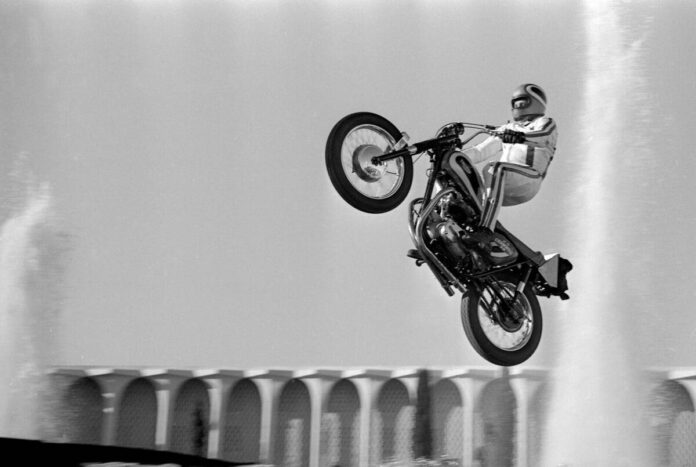Jay Sarno Jr. and the Myth of Evel Knievel
A Legendary Family Legacy
On a vibrant Sunday afternoon, Jay Sarno Jr. found himself immersed in a world of myth and memory, hosted at the Roman-themed resort that his father founded, Caesars Palace. In a presentation titled “Two Sides of Jay Sarno,” alongside Las Vegas author David Schwartz, Sarno took the opportunity to dispel some longstanding myths surrounding one of the most infamous events in Las Vegas history.
The Evel Knievel Jump: Fact vs. Fiction
Sarno, the oldest child of Jay Sarno, who is renowned for establishing both Caesars Palace and Circus Circus, specifically addressed the legendary jump made by Evel Knievel over the Caesars fountains on New Year’s Eve, 1967. This daredevil stunt has been shrouded in exaggeration, leading many to believe that Knievel narrowly escaped death that night. However, Sarno provided clarity, stating that although Knievel suffered significant injuries—including multiple fractures in his pelvis, femur, and hip—his near-death experience was largely sensationalized.
“When you’re in the business of entertainment, you’ve got to sell stories,” Sarno explained. He recounted a pivotal lesson learned early on, noting that his father remarked, “Moron Blows Jump!” isn’t great for headlines; rather, “Man Almost Dies After Jump!” is far more compelling.
Witnessing History and Chaos
At just 9 years old, young Sarno observed the spectacular (and disastrous) jump alongside his father and younger brother, Freddie. He recalled the scene vividly: “We watched Bob [Knievel’s real first name] land funky on the little ramp and bounce out of control, then disappear into the crowd.” This was no ordinary moment; it was a chaotic spectacle that sent shockwaves through attendees and families alike.
The Sarnos swiftly followed the ambulance to Southern Nevada Memorial Hospital (now University Medical Center), where their anxiety mounted. Sarno’s father instructed him and Freddie to stay put on a bench, cautioning them about the weird atmosphere around. An hour and a half of waiting turned into overwhelming fear. “I was crying, and I said, ‘Is Mr. Knievel going to die?’” The assurance given by his father—“No, no, he might walk with a limp. He’s going to be fine”—was a stark contrast to the headlines that would follow.
Marketing Masterclass: Crafting the Narrative
Sarno revealed that his father employed a shrewd marketing strategy that evening, blurring the lines between truth and entertainment. “My dad went around and basically pulled out $100 bills and bribed all the food servers and janitors—not the medical people,” Sarno said, highlighting his father’s cunning in manipulating the narrative surrounding Knievel’s condition.
This orchestration led to a whirlwind of false information flooding the press. Sarno noted how those early concoctions of reality became entrenched within the mythos surrounding Knievel, illustrating how powerful and persistent misinformation can be in shaping historical narratives. “Once you anchor some (BS) like that, it never goes away,” he warned.
The Return of Evel Knievel: A Remarkable Recovery
What happened next was almost as captivating as the jump itself. Knievel returned to the Caesars Palace for dinner three weeks later, walking with a cane but on the mend. Sarno reflected, “They were both crazy gamblers, wild daredevils,” referring not only to Knievel’s audacious stunts but also to the high-risk, high-reward ethos embodied by his father.
A Young Icon in the Making
The discussion turned personal as Sarno shared anecdotes from his own childhood, revealing that he was an ambitious young sprite amidst the glitz and glamour of Las Vegas resort life. His name tag — reading simply “Call Me Jay” — was a nod to his early entry into the family business at just 13 years old, as a worker at Circus Circus. As the ride operator for the bumper cars, he took pride in getting the ride ready for operation, showcasing not only responsibility but an innate understanding of what it meant to manage high-stakes situations.
A Legacy of Innovation and Vision
Schwartz’s 2013 biography titled “Grandissimo: The First Emperor of Las Vegas” encapsulates the vision and tenacity of Sarno’s father. The book highlights how Caesars Palace’s very existence was a marvel of financing and sheer will. Sarno’s dream of furthering his father’s legacy manifested in an unrealized concept for a grand resort—Grandissimo—which was intended to surpass even MGM Grand, capturing the essence of his father’s ambitions.
A Cultural Hub in Las Vegas
As the presentation drew to a close, Sarno’s commitment to sharing his family’s vibrant narrative illustrated not just the history behind iconic events like Knievel’s jump, but also the rich tapestry of Las Vegas culture. The festival, designed to celebrate design and culture through engaging discourse, acts as a reminder of the city’s dynamic history—full of daring, risk, and the stories that ensue.
As it stands, Sarno’s reflections illuminate the intersection of personal history and broader cultural phenomena, enriching our understanding of legendary moments in Las Vegas history while showcasing the importance of narrative in shaping public perception.
